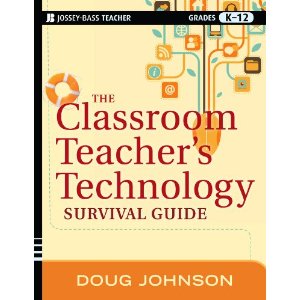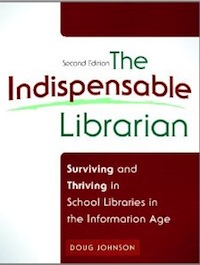Collaboration at a Higher Level
Collaboration at a Higher Level
Head for the Edge, March/April 2014
Doug Johnson
80% of success is just showing up. Woody Allen
I know what Purgatory must be like for school librarians. When student teaching in the mid-70’s in a small rural school, I watched the most hapless librarian I’d ever met trying to do her job – primarily keeping study hall students quiet and busy.
Her simple library space was created from two classrooms pushed together. Perimeter book shelving filled the walls and a high circulation desk stood at one end of the room near the door. The main student seating was provided in several rows of tall-sided study carrels running in long aisles down the length of the room. From the front, one could see the students’ backsides jutting out, but not much else.
The purpose of the carrels, I’m sure, was to help students focus and stay on task. To discourage talking and create an environment conducive to studying. But whenever I visited, the poor librarian was running up and down those aisles of carrels trying to detect which students were making the little bird noises that they knew drove her crazy. I’m guessing this happened every hour of every school day.
That old high school has since burned down. I like to think it was the act of a merciful God.
A few years later when I was a school librarian myself, I overheard my principal say that he thought tall-sided carrels would be just the ticket for helping students work quietly in the new high school library the district was planning. Oh, oh. I decided it might not be a bad idea to get on the facilities design committee. I realized that I needed to collaborate, not just with teachers, but with leadership groups as well.
The booklet School Library Research Summarized1 analyzes 20 years of the impact of school library programs on student achievement. It says:
… it has been shown that incremental increases in the following [library program attributes] can result in incremental gains in student learning:
-
increased hours of access for both individual student visits and group visits by classes;
-
larger collections of print and electronic resources with access at school and from home;
-
up-to-date technology with connectivity to databases and automated collections;
-
instruction implemented in collaboration with teachers that is integrated with classroom curriculum and allows students to learn and practice 21st century skills, such as problem-solving, critical thinking, and communication of ideas and information;
-
increased student usage of school library services;
-
higher total library expenditures; and
-
leadership activities by the librarian in providing professional development for teachers, serving on key committees, and meeting regularly with the principal. [emphasis mine]
While collaboration with individual teachers is important to a successful library program, collaboration with school leaders and membership on school leadership teams is critical - and too few building librarians recognize this. We tend to focus on working with individual teachers, rather than the entities who give those teachers their direction.
Not only does working with other leaders help librarians stay informed about their building’s and district’s goals and priorities, it also gives us a voice in helping create those goals and priorities - allowing librarians to lead.
Given the division in philosophies about how to best teach reading, how to best measure student “achievement,” what priorities should be given to higher order thinking skills and creativity; and, indeed, even what the purpose of education itself should be, no conscientious educator can remain mute - or simply grumble to peers.
Librarians, you can and should be serving on at least one, if not more, of these teams in addition to meeting regularly with your building principal:
-
Building/site leadership team
-
Curriculum teams
-
Assessment committees
-
Strategic planning initiatives
-
Technology advisory committees
-
New facility planning task forces
-
Parent-teacher organizations
-
Accreditation/program review teams
By virtue of training and experience, we in the library profession hold unique and valuable insights into the way children learn, what creates a positive school climate, and what students need to know and be able to do to be successful adults. As Woody remarks above, just showing up gets one a long way. But I would advise that the final 20% consists of being persuasive when participating on committees, teams, and task forces. This means having research, expert opinion, and studies to back up one’s views and values. Know the research that supports voluntary free reading; understand why creativity and higher order thinking skills, not just test-taking skills, are critical to student success; and know what studies show make an impactful library program.
In a climate in which children’s futures are being sold for political points or few dollars of extra profits by educational corporations, to remain silent is unprofessional, even unethical.
Show up. Speak up. Collaborate. Lead. Don’t wait to be invited.
By the way, I avoided getting study carrels in that new library I actively helped design - and the bird noises that may have accompanied them.
1. Kachel, Debra E. School Library Research Summarized: A Graduate Class Project, Revised Edition. Mansfield University, 2013 <http://sl-it.mansfield.edu/upload/MU-LibAdvoBklt2013.pdf>




